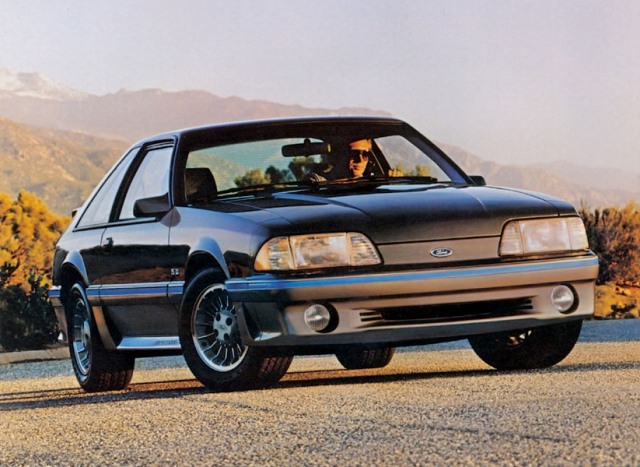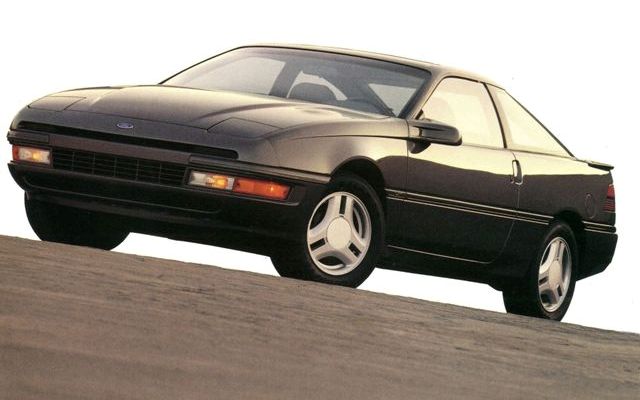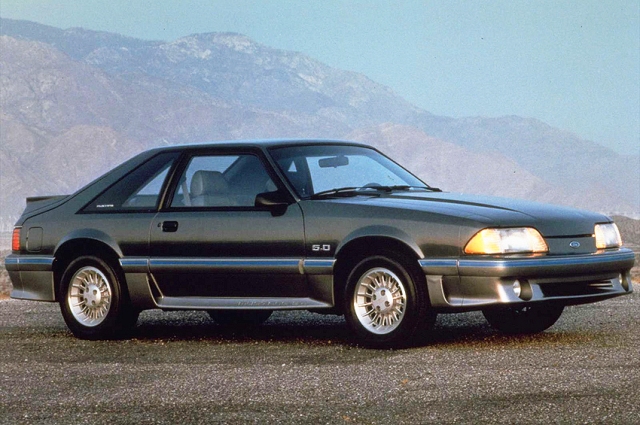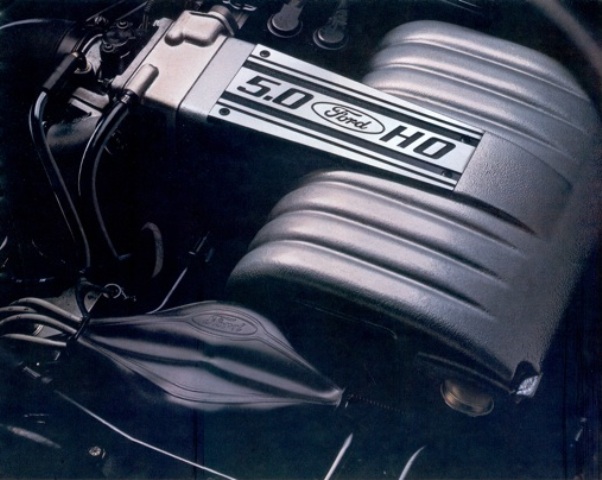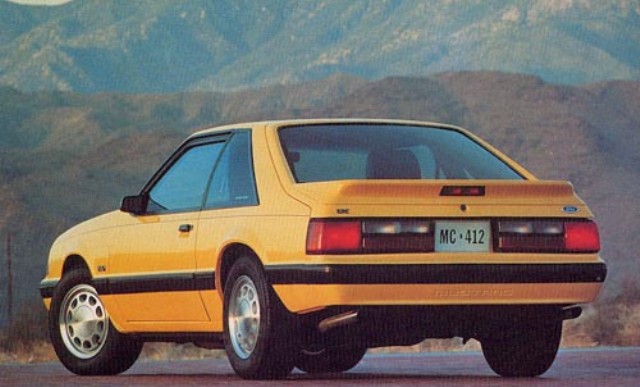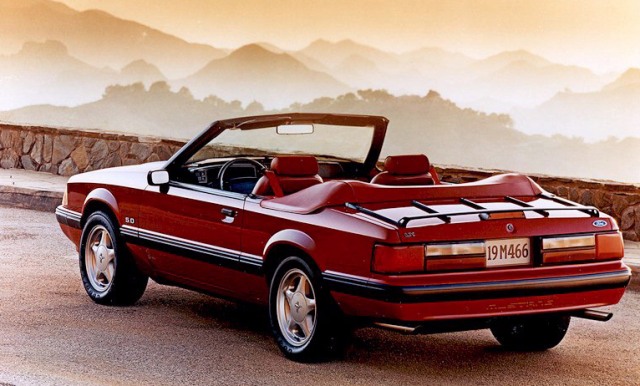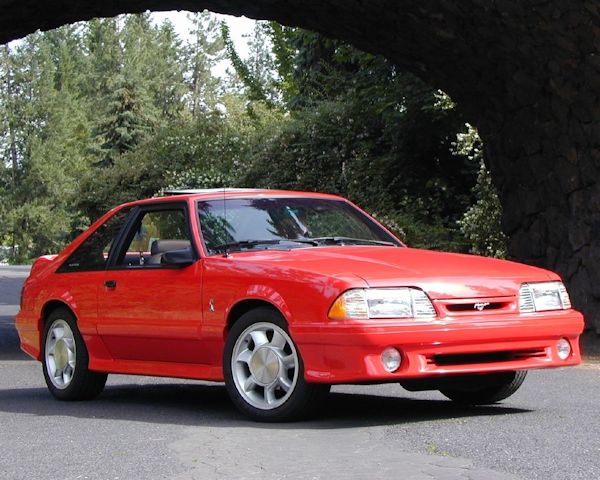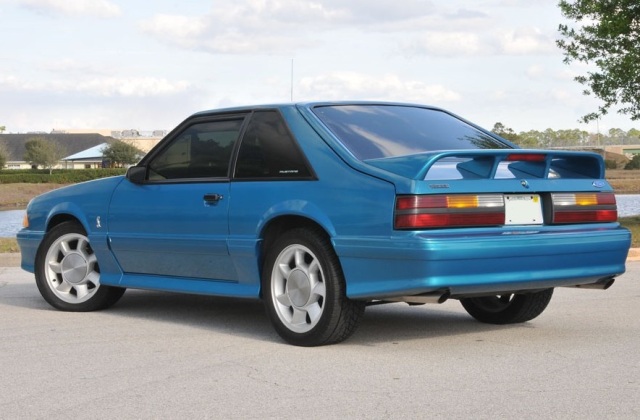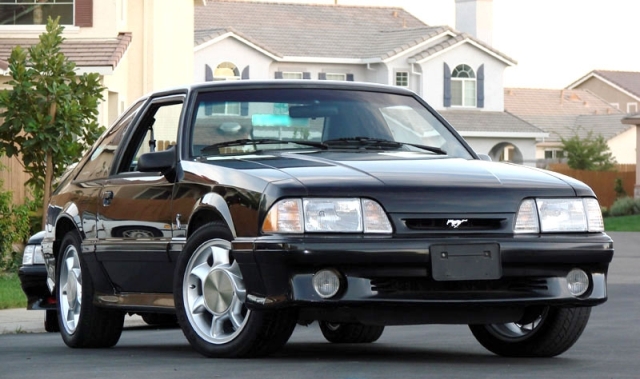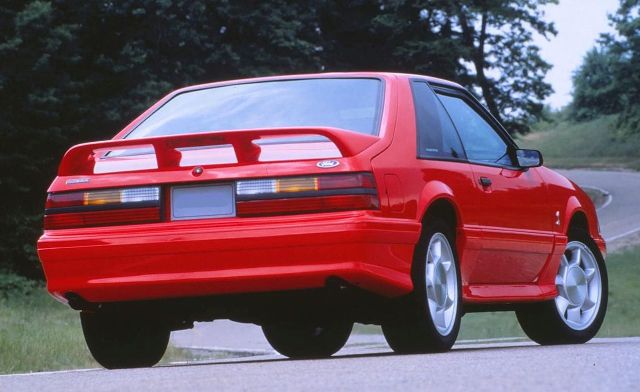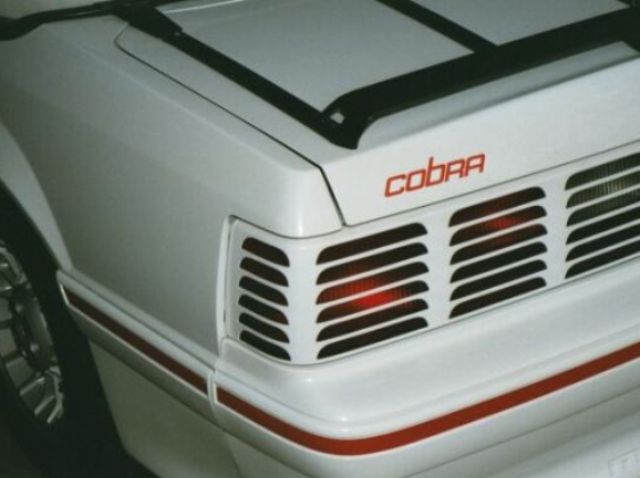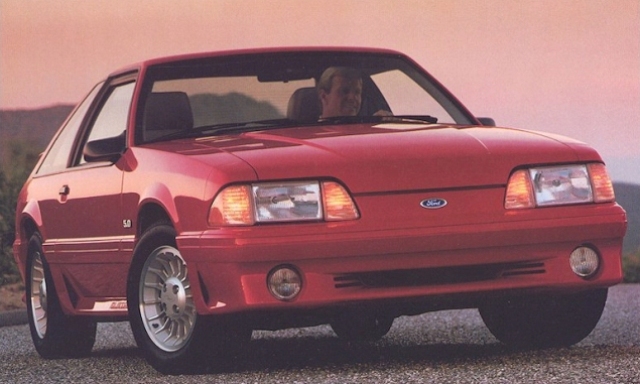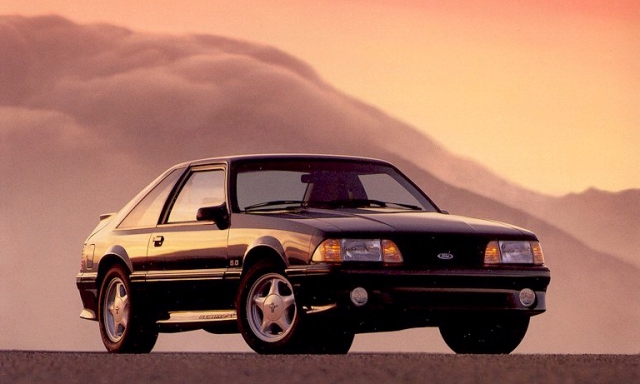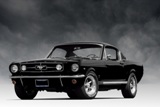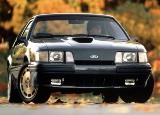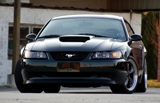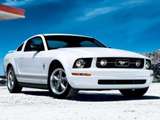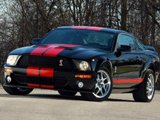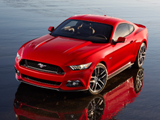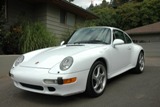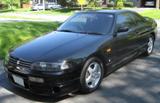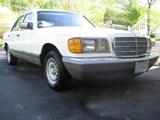Enthusiast's Corner
1987-1993 Ford Mustang: An inspiration for a generation
Written by James Dolan
Nineteen eighty-eight was going to be the last year for the Fox body Mustang or so were Ford’s plans. Ford was diligently working on a new Mustang that would take the brand in a completely new direction. The new Mustang was going to change to a front wheel drive layout with four cylinder power plants forgoing nearly 25 years of rear wheel drive and a V-8 engine tradition. Mazda was going to supply Ford with engines, transmissions and the platform for the new Mustang. Interior and exterior styling was handled by Ford and would take the Mustang far into the future.
Ford genuinely thought that the days of V-8 powered sports cars was over and it was time to move on to more efficient but still fun designs. This new Mustang was Ford’s vision of the future. In the mean time Ford gave the 1987 Mustang its first substantial refresh that would keep the Fox body Mustang interesting and current until the new car was ready for the 1989 model year. However when rumors started to surface in 1987 that Ford was doing away with the traditional rear wheel drive V-8 powered Mustang for a front wheel drive Japanese inspired compact sports hatchback Mustang enthusiasts revolted in a massive way.
The Mustang faithful were furious and inundated Ford with letters. These were not just polite ‘please don’t ruin our beloved Mustang’ kind of letters, no, this was all out hate mail! Seemingly overnight Ford received about 30,000 letters from customers stating their displeasure over the possibility losing what many saw as a symbol of American life. Executives were shocked at the response and knew that if 30,000 people took the time to write scathing letters to the company, there were hundreds of thousands other people who were sitting at home seething. Ford relented and gave the Fox body Mustang a reprieve for the moment and continued production until a suitable replacement could be designed or when sales of the Mustang finally petered out.
But Ford had a problem, development of what was supposed become the new Mustang was too far along to abandon. Too much money and time had been invested and they could not ashcan the car. Their solution was simple; sell the new car right along side the current Mustang. They called the new car the Probe and although it might appear foolish to sell two four seat sport coupes along side one another, both cars appealed to different markets. Buyers of Mustangs and Probes rarely cross-shopped between the two vehicles since both cars were so different from one another. In fact, the Probe nicely filled a gap in Ford’s line-up. Sophisticated four cylinder Japanese sports coupes were gaining in popularity and many of those buyers wouldn’t even consider a Mustang and pass right by a Ford dealership when shopping; now they had a reason to drop in. However the company still needed to deal with the problem of an ageing Mustang and would have to devise a new plan.
Ford changed gears and started work on a new Mustang for a 1990 or 1991 launch. Then on Monday, October 19th, 1987 the stock market crashed and Ford got nervous. Besides, the current car was selling well, company profits were high and the resources that would be used developing a new Mustang could be put to better use on other projects. Plans for a new Mustang floundered for at least two more years until rumors that GM scraped plans for a front wheel drive Camaro and decided to build a new rear wheel drive V-8 powered pony car to be introduced for 1993. In the end the Fox body Mustang stayed alive until the end of 1993, fourteen years after its inception in 1979.
1987 Mustang
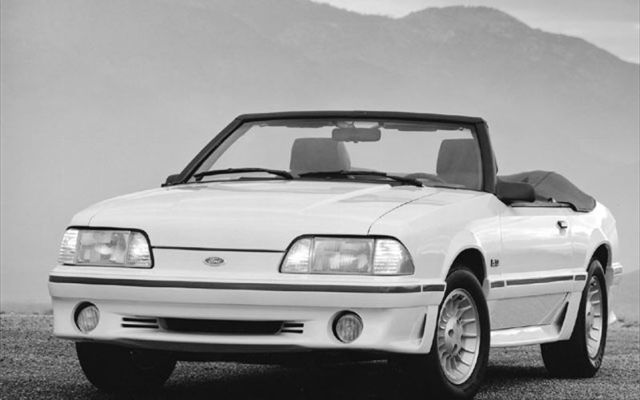
1987 Ford Mustang GT Convertible
Sitting next to the innovative and aerodynamic Taurus, the 1986 Mustang looked very old and out of date. To remain relevant Ford knew that the Fox body Mustang required a major update both on the outside and interior. This led to the Mustang’s most comprehensive redesign since 1979. Notchback coupe, hatchback and convertible body styles all returned for 1987 along with the LX and GT model series. Once again the LX was available in any body configuration while the GT was restricted to either the hatchback or convertible. Engine choices were also paired down to just two, the ubiquitous 2.3-litre inline four and the hard-charging 5.0-litre V-8.
The external appearance garnered a thorough makeover with new front and rear clips and detail changes in between. All models now included a smoother, rounder nose with SVO like wraparound composite headlamps. Quarter glass on notchbacks and hatchbacks were now flush mounted and extended out. A black ceramic band etched into the glass filled the area where the sail panels were once located. All window trim, mirrors and belt moldings and door handles were finished in black. Bumpers and trim were different between the LX and GT with the LX having a more conservative look.
The front bumper on LX’s had split wrap around body side moldings finished in black that bore a striking resemblance to the ones found on the SVO a year earlier. The grille was a simple slot affair with a single bar that bisected its upper and lower halves and housed a Ford blue oval. Black body side moldings stretched along the sides of the car and wrapped around the revised rear bumper that had ‘MUSTANG’ embossed into it. The wrap around tail lamps were given a new look; however the locations of the stop, turn signal, reverse and tail lights remained in the same location as before. All hatchbacks were endowed with a rear spoiler, notchbacks made due without a wing and convertibles were equipped with an ornamental luggage rack. Styling of the LX may have been conservative but it was clean and classy devoid of any unnecessary distractions.
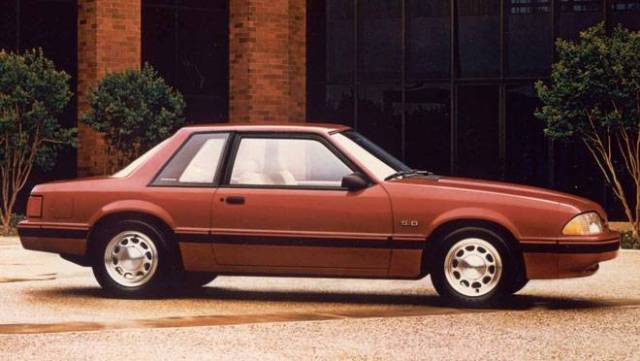
1987 Ford Mustang LX 5.0 Coupe
The GT was given a personality all its own with an aggressive, grille-less nose clip with a deep air-dam and integral round fog lamps. Air was ingested into the engine compartment through a wide intake that was located between the fog lights. This grille-less design was shared with many new Ford’s at the time and these cars quickly became know as “bottom breathers”. Heavily sculpted side skirts with large forward facing non-functional scoops were attached to the side of the car below the body coloured protective moldings. To further differentiate the GT from a lesser Mustang LX unique 15-inch turbine style aluminum wheels were included.
At the rear the GT was given its own distinctive deep rear bumper and louvered tail lamp covers that were of questionable taste. Hatchback GT’s had their own rear spoiler that differed from the LX and convertibles inexplicably had the same useless luggage rack that was found on the convertible LX’s and really didn’t suit the aggressive character of the GT. Capping off the car was large “MUSTANG GT” lettering molded into the rear bumper cover and side skirts. There was no mistaking this car for anything else other than a Mustang GT!
One area in desperate need of a makeover was the interior. The previous dash was the same basic design from 1979 and had been shared with the Ford Fairmont. What worked fine back in ’79 was sorely outdated by the mid ‘80’s. Ford designers came up with a completely new look for 1987 that was Teutonic in style with modern execution and ergonomics. Large vents greatly improved ventilation and side window demisters improved visibility when the side glass fogged over. Rotary climate controls borrowed from the Taurus made adjusting heat, air conditioning and air-flow an intuitive task. Pod mounted instrument cluster switches controlled the functions for hazard lights, rear window demister, headlights and fog lamps. A complete set of gauges faced the driver that included a volt meter and oil pressure gauge along with a 7,000-rpm tachometer, speedometer, fuel and temperature gauges. Steering wheel, console door panels and armrests were all modernized and improved for greater utility and comfort. Finally the Mustang was raised up the same standard as other vehicles in Ford showrooms.
Sitting between the front fenders in base model Mustangs was the stalwart 2.3-litre four-cylinder engine. After many years of being ignored the “Lima” engine received some overdue attention. The single-barrel carburetor was finally swapped for multi-port electronic fuel injection controlled by Ford’s EEC-IV engine management system. This greatly improved drivability with easier startup and a smoother idle. Power was up slightly too with 90-horsepower and 130 pound-feet of torque on tap. New transmissions further refined the base Mustang into a much more pleasant automobile. A five-speed manual transmission and optional four-speed automatic replaced the archaic four-speed manual and three-speed slush-box from the previous generation. These gearboxes went a long way to help suppress the 2.3-litre’s vibration and boom at highway speeds and reduced fuel consumption by reducing engine revolutions.
The hard-charging 5.0-litre H.O. V-8 gained an additional 25-horsepower and 15 pound-feet of torque with the addition of freer-breathing heads and other minor tweaks. Peak horsepower and torque was now up to 225-horsepower and 300 pound-feet respectively. Better still was the penalty of reduced power when the automatic transmission was ordered was now a thing of the past as all V-8 Mustangs now shared the same state of tune. The increased power delivered improved straight-line acceleration performance giving a manual transmission 5-litre Mustang the ability to crack off six to six and a half second zero to sixty mile an hour acceleration times. This level of performance was on par with exotics like the Porsche 928 and Chevrolet Corvette.
Mustang’s continued to offer great value for the dollar in 1987. LX models offered decent fuel economy, excellent reliability and a long list of standard features at a reasonable price. But it was the V-8 powered cars that offered the best value, particularly the popular LX 5.0 that was considered to be the performance bargain of the decade. For a premium of only $1,885 LX’s could be equipped with the 5.0-litre engine package that came with all of the GT’s mechanical upgrades without the frivolous extras. This package was so popular that Ford actually ran short of engines due to demand. It’s not hard to see why the 5-litre Mustang was in such demand. With right around $10,000 a person could walk into a Ford dealer and walk out with a car that could keep pace with premium vehicles that cost three times as much or more.
Not only did it go in a straight line fast it could handle corners pretty well too. Some of the lessons learned during the development of the SVO were transferred over to the GT and LX 5.0. Caster changes, better bushings, upgraded ball joints from the SVO, improved sway bar mounts and a new crossmember all combined to make a 5-litre Mustang into a pretty decent handling car that was actually a joy to drive on twisty roads. For what it was the Mustang was a pretty decent road car. Even close to its limits it could be driven fast safely with progressive, predictable handling. With new sound-deadening techniques the Mustang even went down the road with less noise intrusion into the cabin.
Not everything was pure perfection though. To keep the price low some sacrifices had to be made and it was the brakes that were the victim of cost cutting. Even with enlarged front disc brakes the Mustang’s braking was inadequate. To save money Ford continued to use the same drum brakes at the rear that had came with the car back in 1979. With the added power over the years the old drums just couldn’t cope and with the front doing all the heavy work they were quickly overwhelmed as well. The sensational four-wheel disc brakes that were standard on the SVO weren’t even available as an option on the 1987 Mustang. Many buyers would have probably paid the premium for the added stopping ability, even as an option. It’s a shame that Ford decided not to equip the Mustang with the braking system that it deserved since the rest of the car was so good. That said and despite the fact that the Mustang wasn’t perfect, it was still an amazing performance car value with other vehicles in its class costing thousands more.
1988-1993 Mustang
Over the next five years the Mustang continued on year after year with minimal changes yet journalists continued to have a love affair with the car. Enthusiast publications would continually rank the 5-litre Mustang high on their top ten lists and in performance car comparisons. It might have been old but the car’s attributes and low price allowed the car to remain competitive even against much more sophisticated machinery. Year after year the press crowned the Mustang as the best “Bang for the Buck” performance car available in North America. Ford kept the price low and could do so since all the tooling used to manufacture the car had been amortized long ago.
Nineteen eighty-nine was the Mustang’s 25th anniversary and despite the milestone Ford didn’t produce a special edition vehicle to mark the occasion. Leading up to the twenty-five year mark rumors persisted that Ford would introduce a special Mustang with either a 5.8-litre engine or install the supercharged 3.8-litre engine from the Thunderbird Super Coupe. Longtime Ford contractor and race car builder Jack Roush proposed that Ford build a twin-turbo 5.8-litre 400-horsepower monster that would make Ferrari drivers run and hide. He even went as far as to build a prototype, a car that still exists to this day, but Ford didn’t do a thing.
It wasn’t for a lack of trying, Ford did make a few 5.8-litre test vehicles and even tested a supercharged 3.8-litre Mustang however for various reasons, be it time constraints, cost, or fuel mileage concerns, a Mustang with a special engine was never put into production. In fact Ford did nothing special at all to celebrate the Mustang’s birthday save for a running horse emblem with “25 years” inscribed underneath and affixed to the passenger side of the dashboard on cars produced from April 17, 1989 to April 17, 1990. Mustang fans were justifiably perturbed.
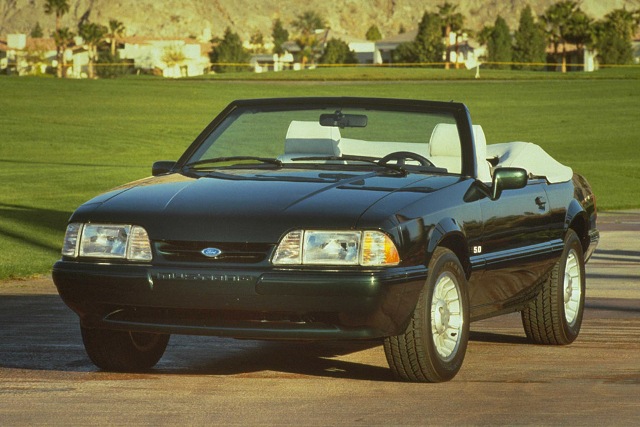
1990 Ford Mustang LX 5.0 Limited Edition Convertible
A driver side airbag was made standard equipment in 1990 to satisfy a federally mandated requirement that all cars have a passive restraint system. This change eliminated the tilt steering wheel option but the added safety measure was worth the sacrifice of convenience.
After ignoring the Mustang’s birthday a year earlier Ford rolled out a limited edition 5-litre LX convertible in mid-year. This package included a white leather interior, white convertible top, the turbine wheels from the GT, and special deep emerald green metallic paint with colour-keyed bodyside moldings and door mirrors. This package was originally intended to be a marketing give-away by the 7-Up company. Ford was ready to build the 30 vehicles that 7-Up had order but at the last minute the give-away was cancelled and Ford was stuck with two vehicles that they had already built. Ford must have felt the pressure to produce something special for Mustang fans and rather than being stuck with materials and paint that they could not use, Ford decided to order more materials and produce the cars and sell them as limited editions. Ford planned on a production run of 5,000 units however only 4,103 were built. Though not billed as a late anniversary edition, some saw this as Ford’s way of finally recognizing the Mustang’s 25th anniversary milestone.
Entry-level Mustangs received some much needed engine improvements for 1991. The weak 2.3-litre four got an infusion of power thanks to a new twin-plug cylinder head and distributor-less ignition. Power was up to a still unimpressive 105-hosepower but it was better than nothing. Truth be told, these changes were implemented to reduce harmful emissions produced by the engine and the increase in power was just a happy consequence. Most buyers didn’t even notice as most of the Mustangs sold came equipped with the 5-litre engine and generally outsold the four-cylinder model by a ratio of 2 to 1. All eight-cylinder models now came equipped with a gorgeous set of five-spoke 16-inch cast aluminum wheels that replaced the 15-inchers of previous years. Sun worshipers were not forgotten and convertible models got a new top that folded closer to the body for a better top down appearance.
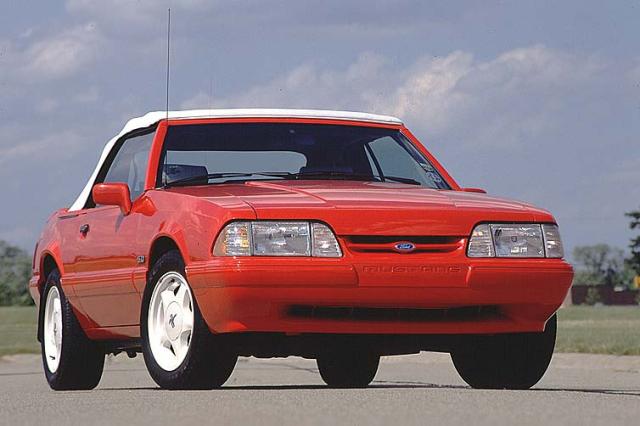
1992 Ford Mustang LX 5.0 Limited Edition Feature Car
Enhancements in 1992 were negligible with LX models receiving colour-keyed bodyside moldings all the way around the car. After a steady decline over the last five years sales hit an all-time low in ’92 with just under 80,000 units leaving showrooms that year. A recession was in full swing that year and car sales as a whole were in the sewer, let alone sports cars. To garner some excitement Ford offered a 5-litre LX convertible “Limited Edition Feature Car” starting in mid-year 1992. All “Feature Cars” were painted Vibrant Red and came with a white leather interior, white convertible top and white wheels that had its finish baked-on. Door trim, window trim and door mirrors were all colour-keyed and a special decklid spoiler replaced the idiotic luggage rack. Inside the white leather seats were contrasted with black piping, a back dash, back carpet and a back headliner. This package added $850 to the price of a LX 5.0 convertible and ended up becoming a rare car with only 2,193 vehicles produced in the second half of ’92.
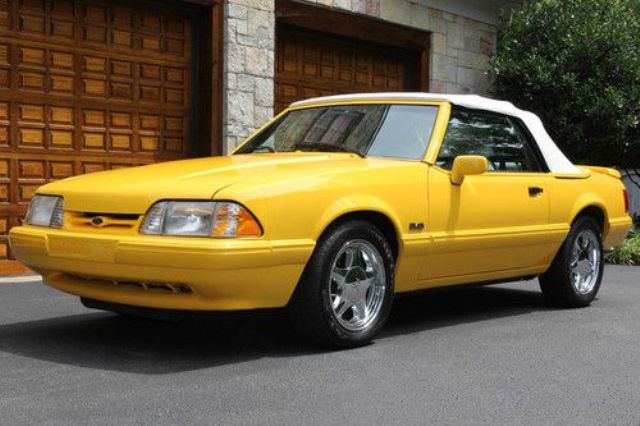
1993 Ford Mustang LX 5.0 Limited Edition Feature Car
With the economy recovering in 1993 Mustang sales rebounded in a big way to 114,228 vehicles and this was with a car that was virtually unchanged. Somehow the 5-litre V-8 lost 20-horsepower and was now down to 205-horsepower without any changes made to the engine or its electronics. Toque was also down as well. Could Ford have been pulling the wool over Mustang enthusiast’s eyes all these years and overrating power figures for the V-8? We may never know and in reality it really didn’t matter since the Mustang was still an amazing performance value.
Once again Ford offered a 5-litre LX convertible “Limited Edition Feature Car”. These cars were essentially equipped the same way as the 1992 “Feature Cars” however this time the cars were offered in a couple of different colour combinations. Of the 3,003 cars made 1,503 were painted in an exclusive Canary Yellow with both a black interior and top combination or with a white interior and top combination. All Canary Yellow cars came with exclusive chrome plated five-spoke pony wheels. The other 1,500 cars were finished in quadruple white with Vibrant White paint, white leather interior, a white convertible top and white wheels. As nice as the Limited Edition LX 5.0 convertible was, it wasn’t the biggest news for 1993. Ford had something else in mind for the Fox Body Mustang’s final year.
1993 Mustang SVT Cobra
The 1993 SVT Cobra is the ultimate prize for any enthusiast of the 1987 to 1993 Fox body Mustang. This special limited edition Mustang was an epic combination of high powered V-8 performance and chassis tuning in a package that was geared towards a more mature market segment. The Cobra was the first vehicle designed and engineered by Ford’s newly formed Special Vehicle Team (SVT) department. SVT took over production car tuning duties from the SVO department so that they could concentrate on their racing efforts and the development of over the counter performance parts. Even despite the Mustang SVO’s disappointing sales numbers years earlier, the management at Ford Motor Company was generally pleased with the car itself and decided it was time to introduce another specialty Mustang into the marketplace. This time however the car would have a rip-roaring V-8 engine under the hood.
All Cobras adhered to the same basic formula using a tuned version of the 5-litre H.O. V-8 in combination with special suspension tuning and backed up by a manual transmission all stuffed into a hatchback body. SVT’s goal was to create a faster, better riding and handling Mustang that looked better and more aggressive. The end product from the SVT group met all expectations than then some. They had created a Mustang that not only could be considered the pinnacle of Fox body Mustang development but what could be one of the best Mustang’s of all time.
The heart of the Cobra is a modified 5-litre V-8 that utilized many parts from Ford’s own Motorsport parts catalogue. A hotter camshaft was installed and actuated a set of aluminum roller-rocker arms that were specifically designed for use in the Cobra. Those rocker arms were installed in a pair of GT-40 cylinder heads that featured larger valves and a better intake port design that improved engine breathing. Sitting a top the heads was a GT-40 lower intake manifold and a special tubular cast aluminum upper intake modeled after the GT-40 upper manifold. Controlling the amount of air allowed into the engine was a larger 65-millimeter throttle body in place of the 60-millimeter unit use on regular H.O. spec engines. Fuel delivery was handled by higher volume 24lb/hr fuel injectors that could better take advantage of the increased volume of air that the engine could ingest. An under-drive crankshaft pulley was installed for more power but in order keep an adequate flow of coolant though the engine the water pump pulley was appropriately up-sized.
Officially the engine was rated at 235-horsepower, however many experts believe that the Cobra was under rated and actually has an output closer to 250 to 265-horsepower. Backing up the worked over engine was a modified Borg-Warner T-5 five-speed manual transmission. The transmission was fortified with a phosphate coating on second and third gears and steel pocket bearing retainer so that it would be capable of handing the engine’s 310-pound-foot of torque.
An abundance of attention was placed upon the suspension and brakes of the Cobra. In what might seem as a move backwards the Cobra was equipped with softer springs front and rear and a thinner anti-roll was employed in the front. This improved the ride remarkably however SVT engineers made certain that the Cobra could corner with confidence with some other improvements. Shocks and struts were specially valved units from Tokico and wheels and tires grew in size. Wheels were 17x7.5-inch directional aluminum with different castings for the left and right sides. These wheels were the largest diameter wheels ever fitted to a Mustang to that point and realized the desires of SVO engineers from years earlier to install a 17-inch wheel and tire package on the Mustang. Tires were now huge 245/45ZR17 Goodyear’s that offered copious amounts of grip. By softening the suspension and adding a massive wheel and tire package the engineers created a Mustang that actually handled better in real world situations. This is because the car would not hop, skip and crash over bumps in the road therefore providing better tire contact on rough pavement. A better ride was a wonderful bonus.
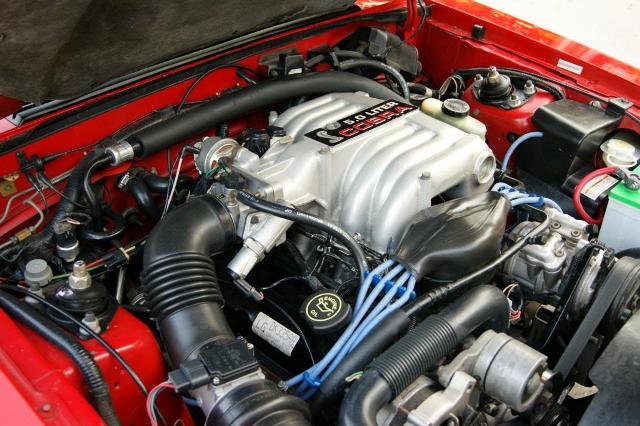
1993 Ford Mustang SVT Cobra Engine
With the exception of the SVO, all Fox body Mustangs suffered from sorely inadequate braking systems. The engineers at SVT wanted the 1993 Cobra to be an exception to that rule. The front ventilated disc brakes from the GT were retained in the Cobra but the rest of the system was tossed. At the rear the Cobra received a set of 10.07-inch discs that were sourced from the 1987-1988 Thunderbird turbo Coupe. A larger brake booster was added to help cope with the extra stopping power. Finally the Mustang had been given the four-wheel disc brakes it had cried out for, even if it was on a limited production car.
The exterior of the Cobra received its own subtle detail changes that may not seem obvious at first but go a long way in making the car look more pleasing to the eye than the boy-racer inspired GT. The flat panel between the headlamps was replaced with a slotted grille with a small running pony in the centre. The overly aggressive side skirts from the GT were toned down and lost the fake scoops ahead of the rear wheels. A coiled snake was affixed to the front fender where the 5.0 badges would normally be found.
Changes to the Cobra were the most pronounced at the rear. A shallow, up-turned rear bumper with exhaust cut-outs was installed and the rear spoiler was redesigned to give the car greater stability a high speeds. Rounding out the changes was a subtle “Cobra” badge on the left side of the hatch and a new set of taillights lifted from the grave of the departed Mustang SVO completed the makeover. These taillights might have been a blast from the past but they stilled looked modern and so much better than the over styled units found on the GT. Only three exterior colours were available on the ’93 Cobra; red, teal and black.
Inside, the Cobra was standard GT fair offered in either grey or black. Cloth seats were standard and leather was available as an option. The only distinguishing feature of the Cobra’s interior was a set of floor mats with “Cobra” embroidered into them in red stitching.
On the road the ’93 Cobra was a real screamer. The modifications to the 5-litre engine vastly improved the motor’s high-rpm breathing and the Cobra produced most of its thrust at the upper reaches of the rev range at the expense of some low end punch. This high strung temperament is great on a track however below 2,500-rpm the Cobra felt just a little weak. This lack of low end grunt was slightly amplified by the relatively tall 3.08:1 gear ratio in the rear axel. For those die-hard, low-end torque loving muscle car enthusiasts the Cobra might be a sight disappointment. However for those enthusiasts who love rowing through the gears and exploring the upper reaches of the tachometer and the outer limits of performance the engine in the Cobra was simply sublime. Drive a Cobra hard and memories of the legendary Boss 302 will come flooding back. Perhaps the best part of the engine package was the melodious burble emanating from the exhaust as the tuned V-8 worked happily away under the hood. One of the best sounds in the automotive world is a tuned small block Ford V-8 at full chat and in this realm the ’93 Cobra hardly disappoints.
From the onset the ’93 Cobra was engineered to be a practical road car that could be driven daily in comfort yet could also be very competent and entertaining on the back roads when the driver was feeling frisky. The intent wasn’t to have a harsh riding all-out track car that could only be enjoyed on occasion, the Cobra needed to be enjoyable in most situations. For the most part SVT engineers accomplished their goal. The Cobra not only rode well but had enough grip to be thoroughly entertaining.
However the age of the Fox body platform was starting to show. At its limits the Cobra was a handful and the soft suspension didn’t inspire confidence for the inexperienced driver. And while the four-wheel disc brakes were a welcome change and did improve the Mustang’s stopping ability, anti-lock brakes weren’t available, a feature that was quickly becoming a must have for some people. Quite simply technology had moved on, past the capabilities of the old chassis. On its own and compared to the LX 5.0 and GT the Cobra was a leap forward but next to the all new for 1993 Camaro and Firebird the Cobra just couldn’t climb to the top. That being said the 1993 SVT Cobra is still one of the greatest automotive thrills of the 1990’s.
1993 Mustang SVT Cobra R
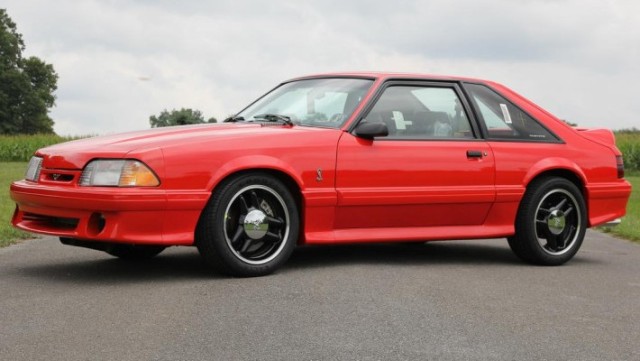
With only 107 produced, the Cobra R is exceptionally rare.
For those hard core weekend track warriors SVT offered a very special run of 107 Cobra R models. These cars were only available to a select few buyers. In order to qualify for purchase every buyer had to have a valid and active racing license. The car featured 17” five lug wheels finished in gloss black that were going to be available as an option on the all new 1994 Mustang. Behind those wheels were larger 13” disc brakes with twin piston PBR calipers up front and 11.65” vented discs in the rear.
Since the car was intended for track use the rear seat was removed and the radio, air conditioner, fog lamps, auxiliary lighting, power windows, power door locks, power mirrors, inner fender liners and sound deadening were all deleted. SVT added an engine oil cooler, power steering cooler and a larger aluminum radiator to keep thing cool under the rigors of track use.
Finally, the suspension was upgraded with a set of race ready Koni shocks and struts, stiffer springs, larger anti-roll bars, front spindles from the up coming ’94 Mustang and a strut tower brace. Every single Cobra R produced was finished in Vibrant Red.
The Canadian Cobra Caper
From 1984 to 1992 Mustang GT’s sold in Canada were marketed and sold as the “Mustang Cobra GT”. This has led to legendary myths and confusion regarding these cars, especially for Americans to the south who thought that the Canadian Cobra was hiding something special under its hood that was unavailable state side. Alas all the rumors of special engines and suspensions were all myths as the Canadian Mustang Cobra GT was just a regular Mustang GT with a “Cobra” decal affixed to its rear end.
So why did Ford of Canada go to the trouble of tagging the “Cobra” name to the Mustang GT? While Ford has never officially divulged the reasoning behind the Canadian Cobra there is a plausible explanation. In order for Ford to hang on to the rights to the “Cobra” name they had to occasionally release a vehicle that used the “Cobra” designation. In 1984 Ford and Carroll Shelby were in the midst of a heated dispute over Ford’s use of the GT350 designation on the 20th anniversary Mustang. In fear of losing rights to the Cobra name to Shelby, or to anyone else for that matter, they decided that they must use the name once again. Because of the lawsuit over the GT350 and not wanting to inflame things even further with Shelby, Ford decided to use the name exclusively and quietly in Canada. This was enough to keep ownership over the name while not creating too much attention.
So while officially these cars were dubbed “Mustang Cobra GT” on window stickers, invoices, brochures and registrations the cars were physically no different than a GT from the United States aside from a “Cobra” decal affixed to the rear end. Interestingly, not all Canadian GT’s have the “Cobra” insignia on the decklid and those that do have the decal located in slightly different locations. This is most likely because the decal was thrown into the car at the factory or later sent to the dealer and the dealer was responsible for installing decal upon the new vehicle preparation inspection.
While no one can say with any certainty why Ford of Canada sold Cobra GT’s, the owners of these cars have a unique conversation piece.
End of the line
By 1993 the Mustang might have been on the market just a little too long but this seniority did have a great benefit for the tuning crowd. Single handedly the 1987-1993 Mustang can be credited for the creation of the modern tuning market. It gave rise to a large aftermarket of high performance parts that is still going strong today. It also erased the myth that computer controlled fuel injected vehicles signaled the end of simple engine modifications since it was viewed that computer controlled engines could not be modified or tuned easily.
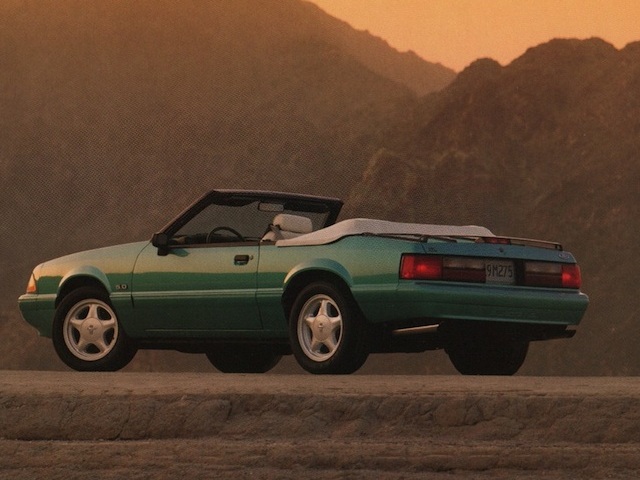
1992 Ford Mustang LX 5.0 Convertible
By 1993 the Mustang might have been on the market just a little too long but this seniority did have a great benefit for the tuning crowd. Single handedly the 1987-1993 Mustang can be credited for the creation of the modern tuning market. It gave rise to a large aftermarket of high performance parts that is still going strong today. It also erased the myth that computer controlled fuel injected vehicles signaled the end of simple engine modifications since it was viewed that computer controlled engines could not be modified or tuned easily.
Because of their performance off the dealers lot and the growing performance aftermarket fueled by Ford’s own SVO department and Motorsports catalogue of parts the 1987-1993 Mustang became cultural icons. The aftermarket is so vast for these cars that today it is nearly impossible to find an original 5-litre Mustang that hasn’t been modified. For a young car enthusiast in the late eighties and early nineties a 5-litre Mustang was the car to have or to aspire too. Forget Ferrari’s or Porsche’s, a Mustang was at the top of the list of dream cars, at least it was conceivably obtainable.
Even today the ’87-’93 Mustang has a loyal and devout following and strong aftermarket support. You can be guaranteed that any enthusiast who was in their teens of early twenties back in the late eighties and early nineties who hasn’t owned a ’87-’93 5-litre Mustang still has one of these cars on their wish list and for this reason these cars will become classics in the future. However all good things must come to an end.
It was clear by the early nineties that the Fox body Mustang had dragged on just a little too long. This became painfully evident when General Motors introduced the all new Camaro and Firebird twins in 1993. Although vastly more practical vehicle than the cars from G.M., the Mustang a clearly lost its edge in the performance department. It was time for a new Mustang and while the 1994 Mustang sported an all new look, something about it was curiously familiar.
Click here to continue reading on the next page about the much anticipated SN95 Mustang...
Most Popular Articles

Japanese Nostalgic Vehicles: The next trend in classic cars
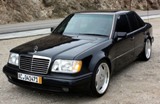
Five Sports Sedan's I'd Love to Own

Hot Hatchbacks From the 1980's

Volvo 200 Series: An Unappriciated Classic

Triumph TR-6: Music to Anyone's Ears
Fifty Years of Mustang
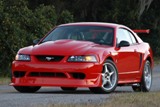
1999-2001 Ford Mustang SVT Cobra
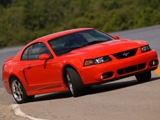
2003-2004 Ford Mustang SVT Cobra
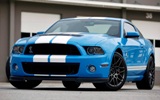
2010-2014 Ford Mustang Shelby GT500
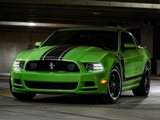
2012-2013 Ford Mustang Boss 302
Driven

Volvo 200 Series: An Unappriciated Classic

Triumph TR-6: Music to Anyone's Ears
1993 Nissan Skyline GT-s and GT-R Coupe

